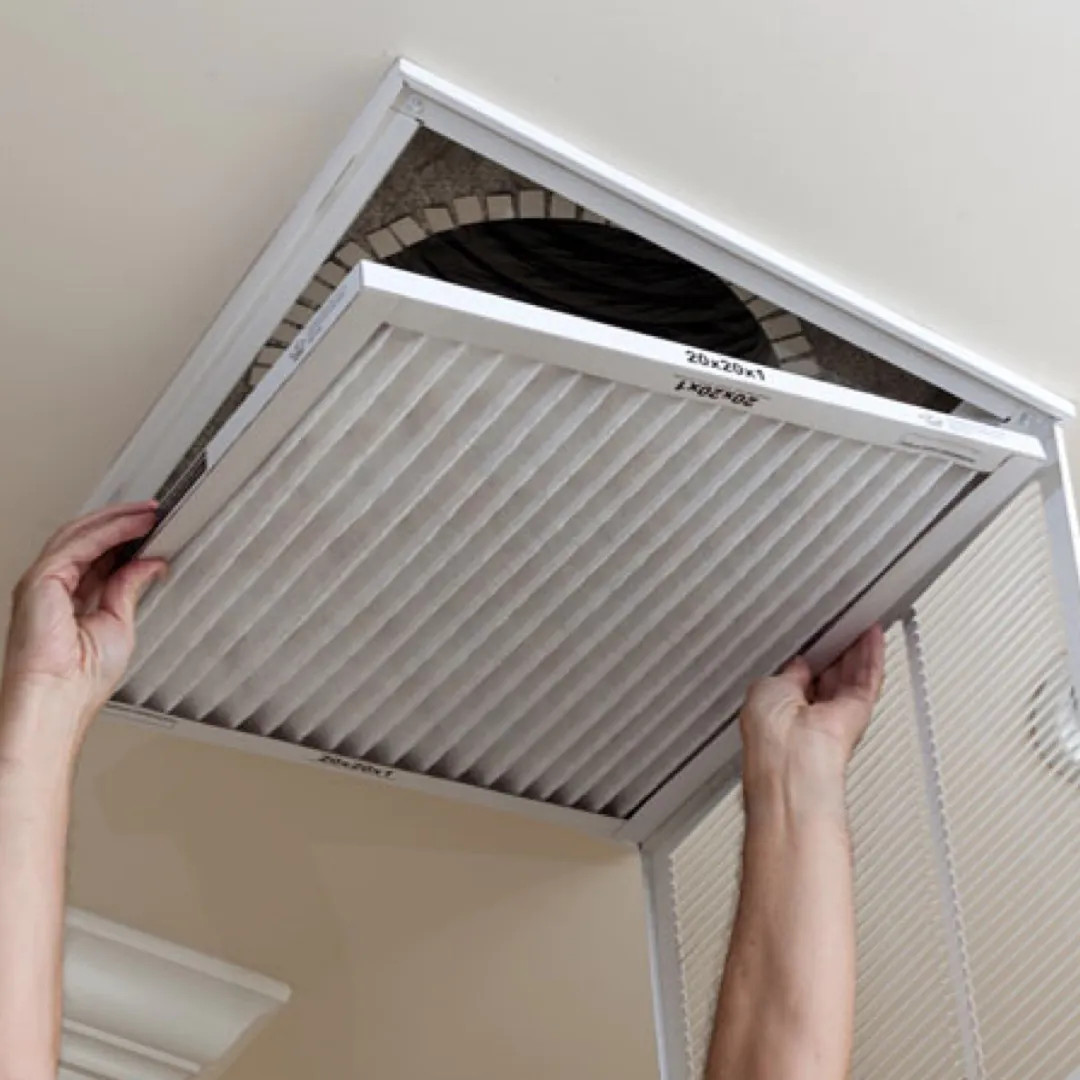The average person inhales approximately 3000 gallons of air per day over the course of around 20,000 breaths. The average person also spends most of their time indoors, whether they're working, eating, or sleeping. So, it makes an awful lot of sense for us to manage indoor pollution and make sure we're breathing healthy air.
Unfortunately, buildings contain many harmful particulates. Most of us probably aren't aware of what's really in the “dust” inside our homes and what we produce when we cook, clean, do laundry, or merely exist inside a house. Many of the particulates that probably come to mind, including pollen and pet dander, can aggravate our immune systems but are usually too large to get into the bloodstream and make us very sick. However, many more particulates, including viruses and bacteria, are small enough to get deep inside our respiratory tracts, enter the bloodstream, and harm us.
The HVAC system is a key piece that can make our homes healthier and manage indoor pollution. However, we first need to understand what's in our air, how it gets there, and how it affects our bodies.
WHAT REALLY IS DUST?
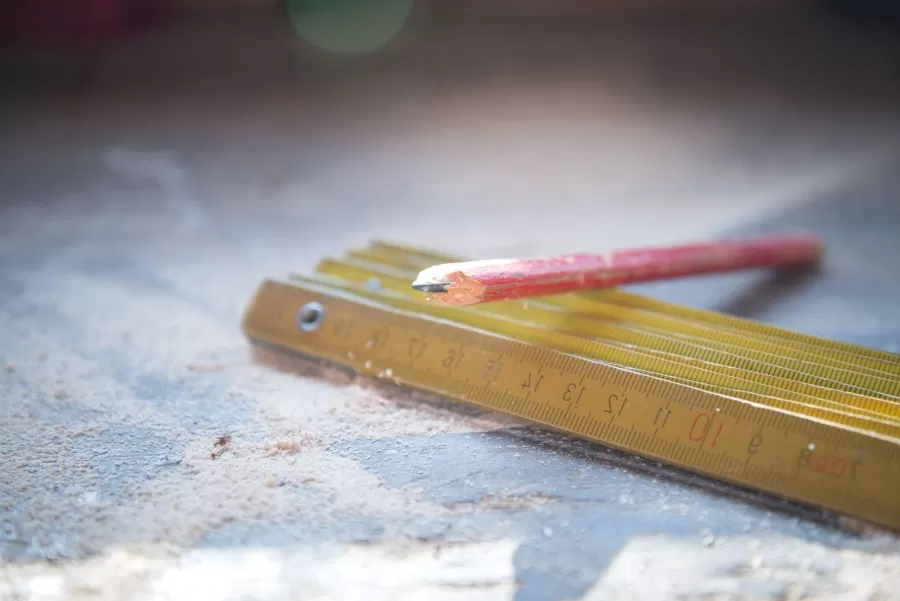
I think most of us have a pretty good idea of what “dust” is. We see it as a film of dry particles that forms on objects that haven't been touched in a long time.
That's dust that has settled. Before dust settles, it's suspended in the air and is often made up of particulates that we can't see. Many of those particulates are dead skin cells; the average person sheds about 7 MILLION dead skin cells per hour! Other biological materials include dust mites, pollen, pet dander, decomposed insects, and spores.
All of those sound pretty gross and could make us cough and sneeze, but they're not exactly unexpected. However, dust can also contain harmful chemicals and heavy metals.
Tobacco smoke residue, pesticides, plastic, fiberglass, and even lead can accumulate in dust! I don't think anybody wants to breathe those in (or at least deal with the health complications that may result).
Now, some of those particulates make a lot of sense; if you smoke cigarettes and live in a house with pets and plants and regularly use cleaners and pesticides, you can expect those things' respective particulates to show up in dust. But what about the construction materials and spores?
INFILTRATION
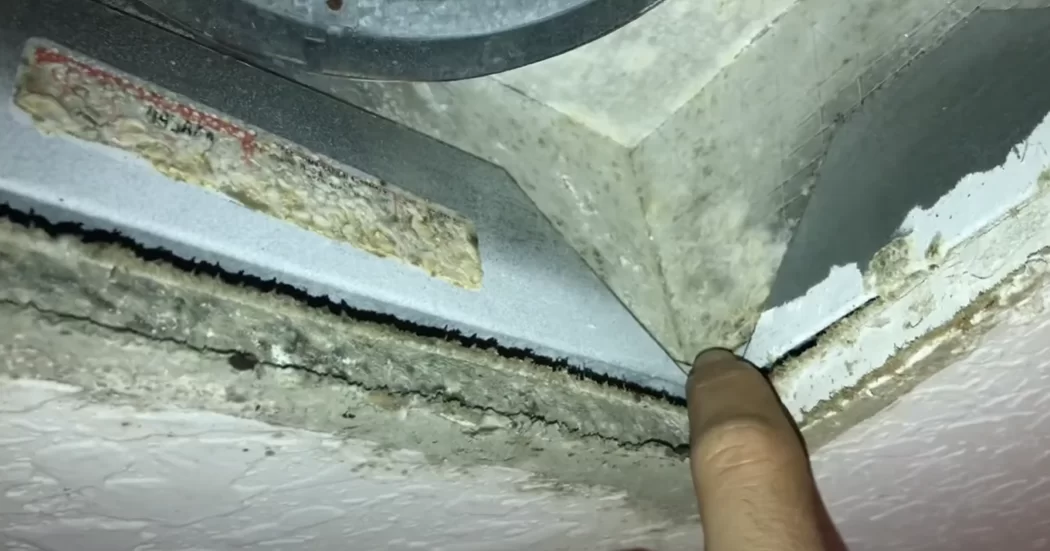
When we think about where our air comes from, we'd like to think that it's been filtered through the A/C system and delivered via vents. Unfortunately, that's not always the case. The photo above shows the “boot” around a supply air vent, which is where conditioned air enters your home from the duct system. The large gap all the way around is a path for attic air to get into the home. The dust and spores from the attic mixed with condensation and became a moldy mess.
If you have gaps and cracks in your home, especially around vents, conduits, and recessed lighting, your house can draw in nasty, unconditioned air from the outdoors or the attic.
We may think that range hoods or bath fans are good for exhausting air pollutants from cooking, washing, cleaning, and other human activity, but they're actually a double-edged sword. While those forms of ventilation will exhaust some pollutants, they pull the house under negative pressure. To replace the exhausted air, the house has to draw in air through gaps in the structure (also known as the “building envelope”). That air is likely coming in through gaps and cracks in the envelope. The HVAC system can't filter or control that air, so all of the particulates infiltrate the home unregulated.
The air that comes in could be from the outside, which may contain pollen and residue from outdoor activities (like burning leaves). Even worse, that air could be coming from the attic, which contains lots of dust and could even contain bacteria and fungal spores.
WHY MANAGE INDOOR AIR POLLUTION?
It's easy to say: “Don't do [X]! It's bad for your health!” So far, I've been pretty broad about the health concerns associated with indoor pollutants. However, there are some specific risks that come from spending a lot of time indoors and inhaling harmful particulates.
Those risks come down to particle size and the nature of those particles.
Particulate size matters
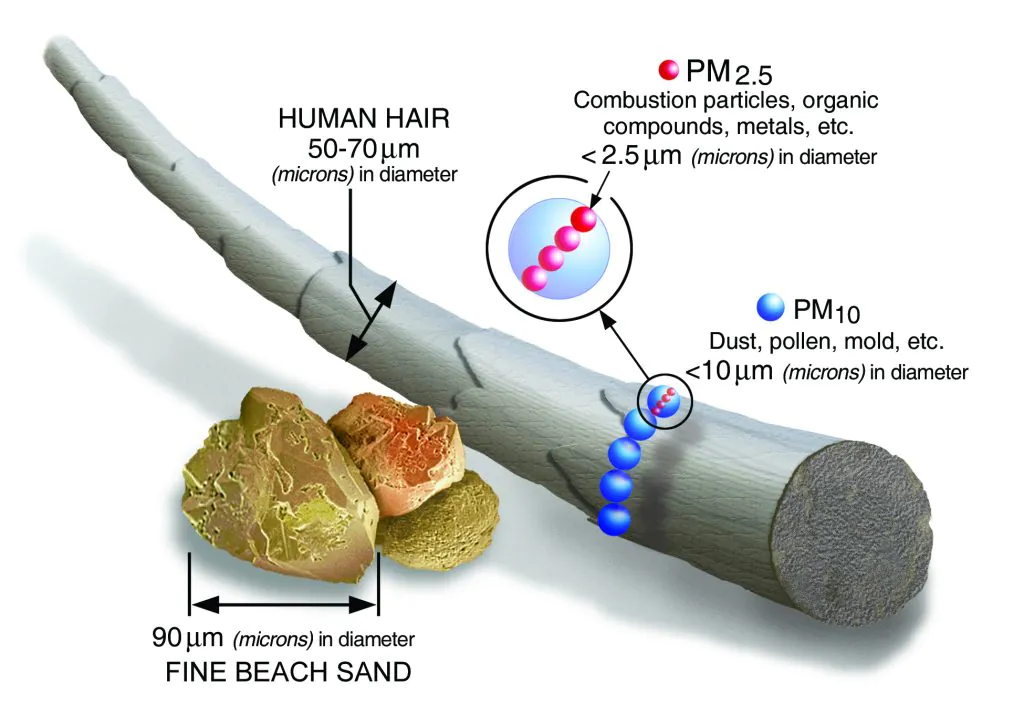
Larger particulates like pollen are unlikely to make it into the bloodstream; they will get caught somewhere in your nose, mouth, or upper respiratory tract. These large particulates can cause allergies and trigger an immune system response, but they are unlikely to cause significant damage to your internal organs. As far as sizing goes, these particulates are called PM 10, which indicates that they are 10 microns in diameter. (By comparison, a human hair is anywhere from 50-75 microns wide.)
Particulates get a lot more dangerous when they get down to PM 2.5 or smaller. These particulates are small enough to enter the small sacs in your lungs (called alveoli) and get absorbed into the bloodstream. Combustion materials, including carbon monoxide gas and smoke, fall under the PM 2.5 category. Heavy metals and mold spores also happen to fall into that category. Bacteria and viruses can be even smaller, with bacteria typically being between 0.5 and 2 microns in diameter, and viruses tend to be around 0.3 microns. The SARS-CoV-2 virus that causes COVID-19 is only between 0.06 and 0.14 microns wide.
Biological pollutants
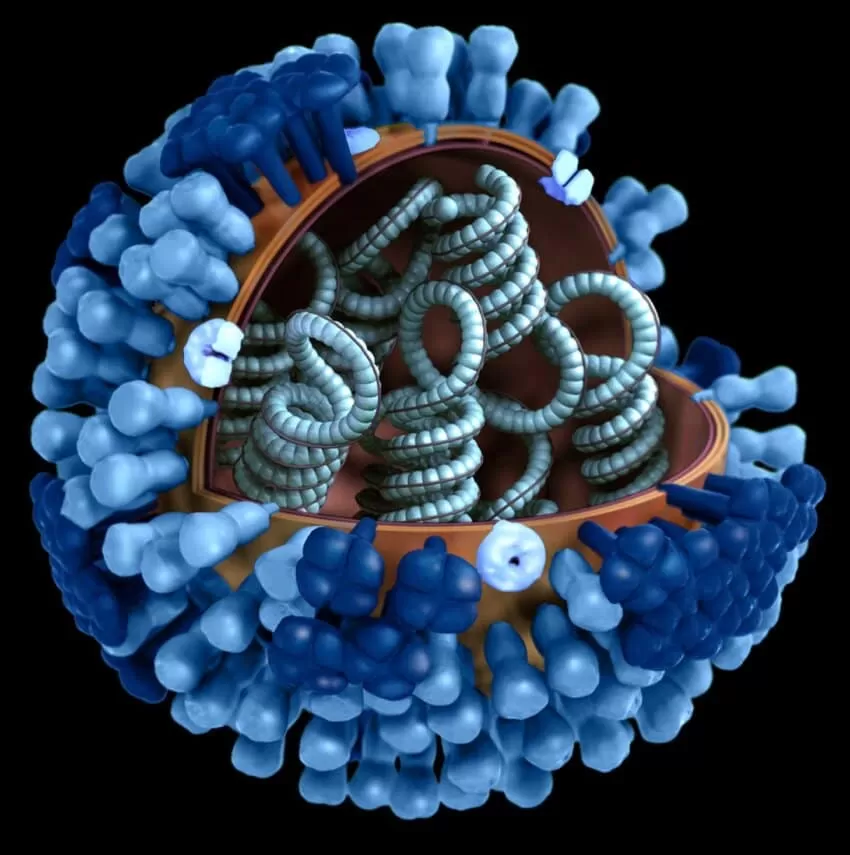
Viruses, fungi, and bacteria are the three main biological pollutants that can make us sick. They can all be smaller than 2.5 microns and are invisible to the naked eye. However, they work in slightly different ways.
Viruses are very small and aren't actually alive, per se. They can't reproduce on their own or grow on surfaces, but they insert their DNA into our cells, and the infected cells continue to go through natural cell division with the viral genetic material. Those bad copies of cells are what make us sick. Because viruses aren't “alive,” we can't “kill” them. Soap and cleaners can deactivate viral proteins on surfaces, but that doesn't help us address viruses in the air. Filtering the air with high-quality media or HEPA filters helps a bit, and diluting the air by bringing in some filtered fresh air helps, too.
Unlike viruses, bacteria and fungi are alive and can reproduce on surfaces and inside your body. Even though individual bacteria and spores are nearly impossible to see, you might still be able to detect them. Bacteria and fungi can cause smelly odors in your home, and fungi can grow into visible patches of mold. Once they get inside your body via your nose and mouth, bacteria and fungi cause infections like pneumonia.
Since bacteria and fungi grow on surfaces, some IAQ products like UV lights can kill them on the surface of your equipment. However, UV lights can only kill the microbes that they shine on, and they're not effective at killing microbes in the airstream.
Chemical pollutants

Chemical pollutants include organic compounds, metals, and products of combustion (fuel burning).
One of the deadliest indoor pollutants is carbon monoxide (CO), which results from the incomplete burning of fuel in gas, oil, or wood-burning appliances. If you have a gas range, fireplace, water heater, or furnace, then you would be wise to keep carbon monoxide on your radar. CO poisoning can cause flu-like symptoms and even death in large amounts. A low-level CO monitor helps you keep track of carbon monoxide near appliances and can help you catch a problem with your equipment before anyone gets sick.
Carbon dioxide (CO2) isn't quite as infamous as carbon monoxide; it's what all animals exhale. However, large amounts of CO2 can also cause occupants to feel fatigued or even sick. You may consider investing in a CO2 monitor if you live in a home with lots of people or animals that stay indoors for extended periods.
Volatile organic compounds (VOCs), especially formaldehyde, are gases that are released from household objects over time. Many of those VOCs are also known carcinogens; taking steps to manage these particulates reduces your risk of developing cancer. Cleaners, paints, flooring, and furniture are just a handful of objects that can attribute their odors to VOCs; the chemical smell of a new couch or a fresh coat of paint comes from VOCs. Even the nice “new car” smell comes from VOCs given off by the upholstery!
Smoking indoors also introduces many pollutants into the home. Formaldehyde, the VOC described above, is also a byproduct of tobacco smoke. However, according to the American Cancer Society, tobacco smoke contains other byproducts that may cause cancer, including arsenic, benzene, and even lead. So, avoiding smoking indoors can keep you, your family, and your pets a lot safer inside your home.
A THREEFOLD SOLUTION
As with most problems, there isn't a simple fix or method for managing indoor pollution. However, the trio of proper construction, regular maintenance, and healthy habits can make your home so much safer.
Proper construction
Thoughtful construction in the first place is a huge help. Plumbers and electricians need to seal the spaces around pipes, wires, or conduits; otherwise, nasty attic air could seep through those openings and travel through the walls. It's also best to seal the cracks around windows, vents, and recessed lighting as a best practice. On the HVAC side, the duct installer needs to be sure that the connections are airtight; duct leakage, especially around collars and vents, is another source of infiltration.
HVAC contractors can also install ventilating dehumidifiers, which can dehumidify the air AND bring in some fresh air through a dedicated return path. The air from the outside passes through filters and gets dehumidified, so you don't have to worry about mixing low-quality air into your conditioned air.
Regular HVAC maintenance
Regular HVAC maintenance is also a key to managing indoor pollution. Some good maintenance procedures include replacing filters, checking duct connection tightness, and cleaning the coils. If duct connections become too loose, an air gap could result. That air gap causes indoor pressure to change and could suck in unconditioned air or exhaust conditioned air.
If you replace your filters frequently enough and have a maintenance agreement with an HVAC company, you can also expect your equipment to be more energy-efficient and last longer.
Healthy habits
The arguably most important piece of the puzzle is the adoption of healthy habits. Avoiding smoking indoors prevents tobacco residue and its byproducts from decreasing the air quality. Frequent filter replacement in homes with pets or plants is also a good habit. Safe cleaner storage is another huge piece; if you can, store chemical-based cleaners outside the home (such as in a shed).
Vacuuming floors with a high-quality bagged vacuum cleaner can help out a lot, too. The bags ensure that the dust and dirt stay trapped inside the vacuum cleaner. Moreover, bags allow for safer disposal.
All of this is just to say that it's important to manage indoor pollution. While some IAQ products like UV bulbs can help, maintaining a healthy home requires a multifaceted approach. You can keep yourself from getting sick from airborne pathogens and chemicals if you have a tight, well-maintained home and adopt healthy indoor living habits.

